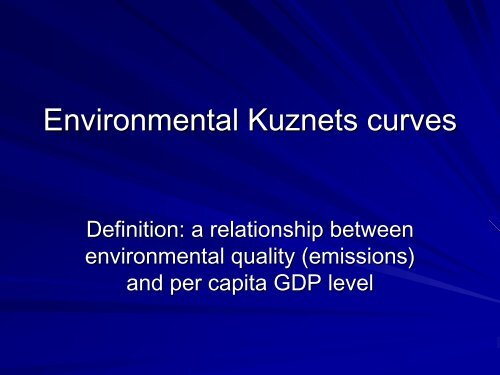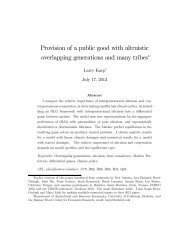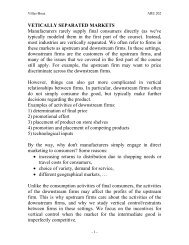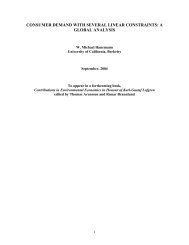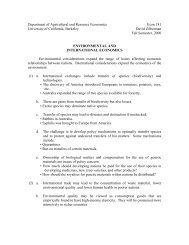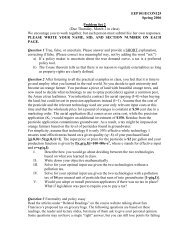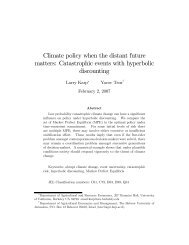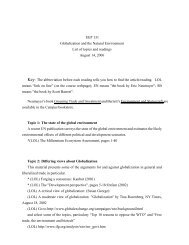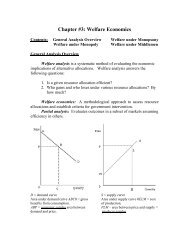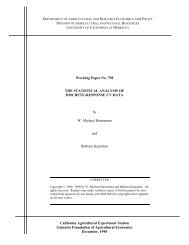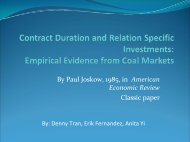Environmental Kuznets Curves - Agricultural and Resource Economics
Environmental Kuznets Curves - Agricultural and Resource Economics
Environmental Kuznets Curves - Agricultural and Resource Economics
You also want an ePaper? Increase the reach of your titles
YUMPU automatically turns print PDFs into web optimized ePapers that Google loves.
<strong>Environmental</strong> <strong>Kuznets</strong> curves<br />
Definition: a relationship between<br />
environmental quality (emissions)<br />
<strong>and</strong> per capita GDP level
Outline: Does it exist, if so why,<br />
<strong>and</strong> is it policy relevant?<br />
Initially, an empirical observation.<br />
Most studies based on cross-country cross country data.<br />
Different results with time series data.<br />
Policy significance?<br />
Structural explanation.
EKC definition<br />
The EKC hypothesizes that the relation<br />
between income per capita <strong>and</strong> emissions<br />
has an inverted U-shape. U shape.<br />
At relatively low income levels, emissions<br />
increase with income, but after some<br />
“turning point”, emissions decrease with<br />
income.
Typical estimation:<br />
Example<br />
ln( EP / ) = α + δ + β ln( GDPP / ) + β (ln( GDPP / )) + ε<br />
it i t 1 it 2<br />
2<br />
it<br />
Turning point is given by<br />
.<br />
− β<br />
exp ( 1 )<br />
2β<br />
2
SO 2<br />
USD 6000<br />
Example<br />
GDP/capita
Empirical evidence<br />
EKC found to hold for some pollutants<br />
(sulphur sulphur dioxide, particles), but others<br />
increase monotonically with income<br />
(carbon emissions).<br />
Differences if study OECD countries or<br />
non-OECD non OECD countries. No or higher turning<br />
point for the latter for CO2 emissions, for<br />
example. (Richmond <strong>and</strong> Kaufman, 2005)
The policy issue?<br />
EKCs have been used as an argument that<br />
economic growth <strong>and</strong> increased environmental<br />
quality go h<strong>and</strong> in h<strong>and</strong>.<br />
They have also been used in support of a do-<br />
nothing policy.<br />
This is not very useful since, if there is a turning<br />
point, we would like to know what factors explain<br />
it before making assessments of whether<br />
environmental policy is necessary or not.
Criticisms of EKC<br />
A reduced form relationship.<br />
Policy relevance? Black box.<br />
The existence of an EKC varies according<br />
to the pollutant: carbon emissions is one<br />
case in point.<br />
Income is exogenous: no feedback from<br />
environmental damage to income level.<br />
Econometric issues.
Methodological issues<br />
The first EKC studies were done on cross-<br />
section data. Can we infer something<br />
about one country’s development based<br />
on an EKC from cross-section cross section data?<br />
Many functional forms can explain the data<br />
(quadratic, other polynomials).
Methodological issues<br />
Omitted variable bias<br />
Have to test for stochastic trends in time<br />
series.<br />
It is the median income rather than the<br />
mean that matters.
Structural explanations<br />
1)Consumption <strong>and</strong> production changes with<br />
income<br />
2)Preferences for environmental quality<br />
3)Policy/institutions for internalizing<br />
externalities<br />
4)Pollution abatement technology<br />
(increasing returns to scale)<br />
5) Dynamic models of resource stocks or<br />
consumer satiation.
1) Consumption <strong>and</strong> production<br />
changes<br />
If industry structure changes from relatively<br />
clean agrarian economies to polluting industries<br />
to tertiary sector, trade <strong>and</strong> delocalisation plays<br />
some role. In a global perspective, there are<br />
limits to this phenomenon.<br />
Scale (GDP), technique (emissions intensity)<br />
<strong>and</strong> composition (output mix) effects.<br />
The example of CO2 emissions: increased<br />
income changes fuel mix, structure of industry.
2) Preferences for environmental<br />
quality<br />
Evidence of increased dem<strong>and</strong> for<br />
environmental quality with increased<br />
income (positive income elasticity for<br />
environmental quality).<br />
Is environmental quality a normal good or<br />
even a luxury good? Kristrom & Riera<br />
(1996): income elasticity less than 1.
3) Institutions/policy<br />
If the dem<strong>and</strong> for environmental quality<br />
increases with increased income, then it is<br />
this dem<strong>and</strong> that forces an active policy on<br />
environment <strong>and</strong> the creation of<br />
institutions to internalize externalities.<br />
There is no natural relation explaining the<br />
turning point – it is the outcome of a<br />
conscious policy choice.
4) Abatement technology<br />
Is technology sufficient to explain why<br />
there can be EKC?<br />
Even without preferences for<br />
environmental quality or externalities <strong>and</strong><br />
institutions to internalize them, increasing<br />
returns to scale in abatement technology<br />
can explain the appearance of an EKC<br />
(Andreoni Andreoni <strong>and</strong> Levinson, 2001).
5) Dynamic modeling<br />
If environmental quality is seen just as a<br />
resource stock then it starts out clean,<br />
then degrades until some level of<br />
maintenance investment is required.<br />
The environmental resource constraint<br />
only becomes binding when there is a<br />
growing population <strong>and</strong> polluting firms.
Some conclusions<br />
EKCs may exist for ambient concentration<br />
of certain pollutants, but for others, the<br />
relationship between income <strong>and</strong> pollution<br />
is monotonically increasing.<br />
Even if an EKC exists, global pollution<br />
may increase, since the fastest economic<br />
growth occurs in developing countries with<br />
the highest population growth.
Some conclusions<br />
Even if an EKC exists, no automatic<br />
relationship – depends on policy variables.<br />
Better study those policy variables <strong>and</strong><br />
how emissions depend on structural<br />
changes.
An Incomplete Bibliography<br />
Andreoni, Andreoni,<br />
J. <strong>and</strong> A. Levinson (2001). The Simple Analytics of the <strong>Environmental</strong><br />
<strong>Environmental</strong><br />
<strong>Kuznets</strong> Curve. Journal of Public <strong>Economics</strong> 80 (2): 269-286. 269 286.<br />
Arrow, K. et al. (1995). Economic Growth, Carrying Capacity, <strong>and</strong> the Environment.<br />
Science 268: 520-521. 520 521.<br />
Copel<strong>and</strong>, B. <strong>and</strong> Taylor, M.S. (2004). Trade, Growth <strong>and</strong> the Environment.<br />
Environment.<br />
Journal<br />
of Economic Literature 42: 7-71. 7 71.<br />
Dasgupta, Dasgupta,<br />
S. et al. (2002). Confronting the <strong>Environmental</strong> <strong>Kuznets</strong> Curve. Journal of<br />
Economic Perspectives 16: 147-168. 147 168.<br />
Grossman, G. <strong>and</strong> A. Krueger (1992). Economic Growth <strong>and</strong> the Environment.<br />
Environment.<br />
Quarterly Journal of <strong>Economics</strong> 353-377. 353 377.<br />
Holtz-Eakin<br />
Holtz Eakin, , D. <strong>and</strong> Selden, T. (1995). Stoking the Fires? CO2 Emissions <strong>and</strong><br />
Economic Growth. Journal of Public <strong>Economics</strong> 57: 85-101. 85 101.<br />
Selden, T. <strong>and</strong> Song, D. (1994). <strong>Environmental</strong> Quality <strong>and</strong> Development: Development:<br />
Is There a<br />
<strong>Kuznets</strong> Curve for Pollution? Journal of <strong>Environmental</strong> <strong>Economics</strong> <strong>and</strong> Management<br />
27: 147-162. 147 162.<br />
Shafik, Shafik,<br />
N. <strong>and</strong> B<strong>and</strong>yopadhyay, B<strong>and</strong>yopadhyay,<br />
S. (1992). Economic Growth <strong>and</strong> <strong>Environmental</strong><br />
Quality: Time Series <strong>and</strong> Cross-Country Cross Country Evidence. Background Paper for the World<br />
Development Report 1992, World Bank, Washington D.C.<br />
Stern, D. (2004).The Rise <strong>and</strong> Fall of the <strong>Environmental</strong> <strong>Kuznets</strong> Curve. World<br />
Development 32(8):1419-1439.<br />
32(8):1419 1439.


